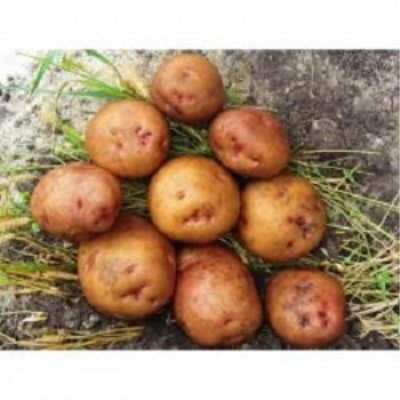
- Authors: Osipchuk A.A., Tereshchenko A.I., Nazar S.G., Sergienko V.M., Zhigailo I.I., Koval N.D., Sheremet N.I., Polozhenets V.M., Sitchenko N.N., Svertoka V.E., Ostapenko D.P., Razkevich N.F., Gaiduk P.P., Vitenko V.A., Pika N.A. (Institute of Potato Growing of the Ukrainian Academy of Agrarian Sciences)
- Year of approval: 1987
- Appointment: universal
- Peel color: red
- Color of the pulp: light yellow
- Starch content,%: 16 - 19%
- Tuber shape: rounded
- Peel structure: smooth
- Flowers: red-purple
- Keeping quality: good
Svitanok Kievsky potatoes are a very popular vegetable crop. It is mainly distributed in the following countries: Belarus, Ukraine, Russia. Potatoes of this type are stored for a long time, and also quite unpretentious. It tastes good and is perfect for frying, boiling or baking.
Breeding history
This type of potato was created and released by breeders from Ukraine. This was carried out at the Institute of Potato Growing of the Ukrainian Academy of Agrarian Sciences for germination in temperate and continental climates.
Svitanok Kievsky was officially entered into the state register of plants of the Russian Federation in 1987. To this day, the variety is considered the best, and it also retains a high rating from farmers.
Description of the variety
This potato easily tolerates light aridity, temperature fluctuations, and excess moisture. The main thing is that any unfavorable reasons and conditions will not affect its taste and the time when it is necessary to harvest.
The plant has a strong immune system against diseases such as scab, late blight, black leg and rhizoctonia.
Svitanok Kievsky is suitable both for home consumption and for selling it, because it has good qualities.
Other advantages of this variety:
- potatoes contain a large amount of minerals and vitamins;
- tubers of the same size;
- yield is always high;
- does not require special care.
Characteristics of the appearance of the bush and root crops
The tops of the potatoes are dark green in color, the leaves are of medium size. The stems do not tend to fall apart, which makes it easier to care for the vegetable. By themselves, they are low, gathered together and of medium thickness. During the flowering period, the plant has abundant pinkish inflorescences.
Svitan's roots are rounded, their ends are slightly elongated. Fruit without roughness. The rind is pink and so thin that you can see the gaps in the creamy flesh. The eyes are pink-red. The weight of one potato ranges from 80 to 100 grams. About 10 tubers develop on one bush.
Purpose and taste of tubers
Potatoes are perfect for various dishes and types of processing. Fruits can be fried, baked, boiled, mashed, various fillings for baking. An excellent find for feeding children or for dieting.
Due to the large amount of minerals and starch contained in the vegetable, the roots have a bright taste, there is no wateriness. And after heat treatment, they become very soft and melt in the mouth. The taste is much brighter and more interesting than other common potato varieties.
Maturation
The main sign that the root crop is ripe is the presence of drying and dying tops. Dig it up in a period of up to three weeks after these signs. If you are late with this action, then the fruits will be poorly stored. Ripening occurs 90-100 days after planting.
In the southern regions, Svitanok Kievsky ripens at the very beginning of July and is ready to be harvested. In colder climates, harvesting begins in July.
It is customary to dig out the harvest in sunny, dry weather.Root vegetables are laid out in one layer and left in a dark place to dry them.
Yield
With this versatile variety, you will reap an excellent harvest. The amount of potatoes per hectare reaches 500 centners.
With proper plant care, the weight of the fruit can increase by 40-50 grams. To do this, you need to follow the same requirements as for sprouting ordinary potatoes.
Growing regions
Svitanny is mainly grown in the following regions:
- Far Eastern;
- Middle Volga;
- North-West;
- Central.
Growing and care
Planting of potatoes begins after April 20 and early May. The soil needs open and sandy loam. The holes are about 7-10 centimeters deep, and the distance between them is 30-35 cm.The rows are made at intervals that are about 60 cm.
The big advantage of this potato is that it can be planted in the same place and the yield will not decrease. This culture grows well on ridges after leguminous plants (lupine, peas), since they are powerful green manures and enrich the land well.
Top dressing is applied by moistening the soil 2 times for the entire season. Mostly poultry manure is used, but mineral fertilizers would be a good option.
Systematic watering is very important to prevent the tubers from cracking. Three times a week will be enough. It is necessary to huddle twice, and every second week you need to carry out weeding, remove weeds.

Planting potatoes is one of the main spring activities traditional for Russian gardeners. There are many ways to plant this vegetable, allowing you to get a good harvest in different conditions and climates. Before planting, you need to carefully prepare the planting material, correctly determine the timing, competently prepare the soil.




Potatoes are a popular vegetable crop that many gardeners planted on their site. But growing a bountiful harvest of tasty and large tubers is unlikely to succeed if the beds are not properly protected from the most common diseases and pests. Often, the development of diseases of various etiologies of potatoes goes unnoticed, so it is important to identify the problem in time and eliminate it.
















































































